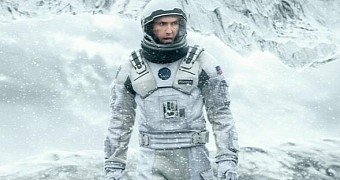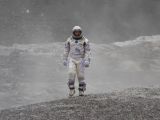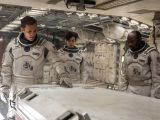“Do not go gentle into that good night,/ Old age should burn and rave at close of day;/ Rage, rage against the dying of the light.” And that it does in “Interstellar,” the ninth and most recent film from writer / director Christopher Nolan.
This bit from Dylan Thomas’ “Do Not Go Gentle” poem is recited over and over by Michael Caine’s character in “Interstellar,” to the point where it might come to feel redundant. It’s not; it’s the very premise that makes possible such a bold, challenging, beautiful, naïve, and ultimately flawed story of voyage through space and time, a cinematic experience like no other this year.
Chris Nolan, a true and rare Hollywood visionary
Chris Nolan is a rarity in Hollywood: not only does he insist on shooting on film and shunning CGI as much as possible, not only does he set out terms for studios distributing his films, which allow him to retain almost complete control over the production, but he’s also a true – and very rare – visionary.
“Interstellar” has been years in the making: he started working on the script with brother / longtime collaborator Jonathan Nolan, but the final draft wasn’t possible until he met and consulted with known theoretical physicist Kip Thorne, who gets a producers credit on the film, about space travel, wormholes, and the space and time continuum.
From that script, with help from an excellent cast, another longtime collaborator, composer Hans Zimmer, and an estimated budget of $160 million (€129 million), Nolan was able to craft “Interstellar,” a film so epic and awe-inspiring, yet also so beautifully imperfect that you simply have to see it to believe it.
“We used to look up at the sky and wonder about our place in the stars. Now, we just look down and wonder about our place in the dirt.”
The end of the Earth is nearly here. “Interstellar” opens in a not-too-distant future in which we have all but consumed all of our planet’s resources, where technology has become redundant because we’re starving to death. Society has turned agricultural again, and the farmer is its new hero, with all efforts going into creating crops that withstand the storms of dust and the killer heatwave.
Still, the Earth is dying, and engineer and former test pilot turned farmer Cooper (Matthew McConaughey) knows it. He lives at a farm in the middle of a huge cornfield with his father-in-law (John Lithgow) and his 2 kids, and despite the dust and the dire prospects for the future, he seems to have built a beautiful life for them as a family.
But you see, Cooper’s children are even smarter than he is, particularly Murph (Mackenzie Foy), and her inquisitiveness leads her to the discovery of a set of coordinates to the NASA secret headquarters. In a world in which man is starving and he has nothing but agriculture to guarantee him a few more years of life, not much value is placed on space travel anymore, hence the need to go underground.
Faced with the cold reality of the death of the planet, Cooper agrees to go on a mission that would find other potentially habitable worlds. Professor Brand (Michael Caine) and his daughter Amelia (Anne Hathway) believe they exist – and that they’re reachable through a wormhole that they’ve been studying for decades.
An experience like no other
Chris Nolan has always been fascinated with themes like time and space (just like he’s been obsessed with the inversion of both on camera), but with “Interstellar,” he makes the exploration of these into his most personal project yet. In doing so, he takes the viewer on a journey like no other, a true cinematic experience that is already drawing comparisons to precursors “2001: A Space Odyssey” and the more recent “Gravity.”
Unlike these two, “Interstellar” is driven by regret, grief and dread, and love, about a lifetime worth of it. A director often accused of being too cold and calculated in his approach, Nolan gets emotional for a change. At points, “Interstellar” becomes downright cheesy, but it never stops being majestic even when it’s shamelessly pulling at the heartstrings of the viewer.
Movies about the end of the world are a dime a dozen these days, but few manage to capture the horror of such a (still hypothetical) scenario in such an intimate way. The same goes for films about space travel: Hollywood has been there, done that countless times.
With “Interstellar,” the viewer sees the world through Nolan’s eyes – and his gaze is at times naïve, at times awed, and occasionally amused. But the perspective never stops changing, impressive both through variety and scale. Make no mistake about it, as flawed as it is, “Interstellar” is an epic and very ambitious film, with no direct rival this year.
Superb acting performances
This might sound like Nolan did all the heavy lifting on “Interstellar,” so a few words must be said about the beautiful performances of all members of the cast, starting with Hollywood’s favorite actor right now, Matthew McConaughey. He was once a surfer-dude type of guy, but with the weight loss, he seems to have gained gravitas and a certain edge / darkness that were never there before.
McConaughey won an Oscar for “Dallas Buyers Club,” but his performance in “Interstellar” comes close to that one. That’s not saying he might be nominated again, just that he did his damned best to prove all critics saying he had no place in a Nolan movie that he could do it. His portrayal of a Cooper torn between the love of his children (and regret at having left them behind) and his desire to save the world (and them) is the fuel that keeps the “Interstellar” machine going.
Outstanding in their own right are female leads Anne Hathaway and Mackenzie Foy, with Ellen Burstyn deserving a huge round of applause. This actress earned an Emmy nomination in 2006 for a performance of just 14 seconds of screentime – and “Interstellar” will show you why.
Rating and runtime
“Interstellar” is rated PG-13 for some intense perilous action and brief strong language, and runs for 169 minutes. That’s almost 3 full hours of runtime, but the film makes every second of it worth it.
It opens tonight, Friday, November 7, in most US theaters and several European countries, will arrive in China on November 12, and ends its run in Japan on November 22.
The Good
This is a movie that’s best experienced than described. Do see it in IMAX, if possible.
The Bad
The Truth
But he never stops making it worth it: “Interstellar” is a memorable cinematic experience and one of the best films of the year. It’s loud and fast, and scary, but it also feels intimate, heartbreakingly human and pure. Nolan has just set the bar higher for himself.

 14 DAY TRIAL //
14 DAY TRIAL // 






